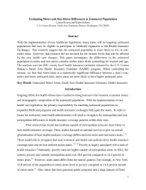
An official website of the United States government
Here’s how you know
Official websites use .gov
A .gov website belongs to an official government organization in the United States.
Secure .gov websites use HTTPS
A lock (
) or https:// means you’ve safely connected to the .gov website. Share sensitive information only on official, secure websites.
-
//
- Census.gov /
- Census Working Papers /
- Evaluating Metro and Non-Metro Differences in Uninsured Populations
Evaluating Metro and Non-Metro Differences in Uninsured Populations
Evaluating Metro and Non-Metro Differences in Uninsured Populations
Abstract
With the implementation of new healthcare legislation, many states will be targeting uninsured populations that may be eligible to participate in Medicaid expansion or the Health Insurance Exchanges. Past research suggest that the uninsured population is more likely to live in non-metro areas. However, that research did not account for the income levels that will be affected by the new health care changes. This paper investigates the differences in the uninsured population in metro and non-metro counties within states while controlling for income and age. The analysis uses the 2011 county-level health insurance estimates released by the U.S. Census Bureau’s Small Area Health Insurance Estimates (SAHIE) program. When controlling for income, we find that where there is a statistically significant difference between a state’s non-metro and metro uninsured rates, metro areas are more likely to have higher uninsured rates.
Share
Related Information
Some content on this site is available in several different electronic formats. Some of the files may require a plug-in or additional software to view.
 Yes
Yes
 No
NoComments or suggestions?


Top


